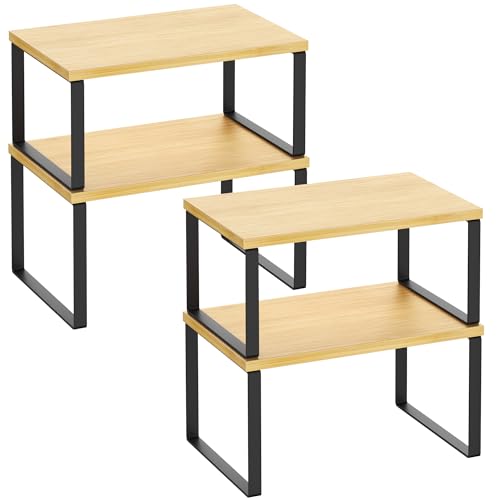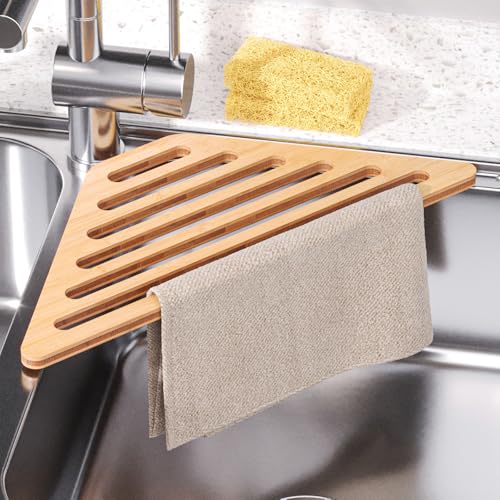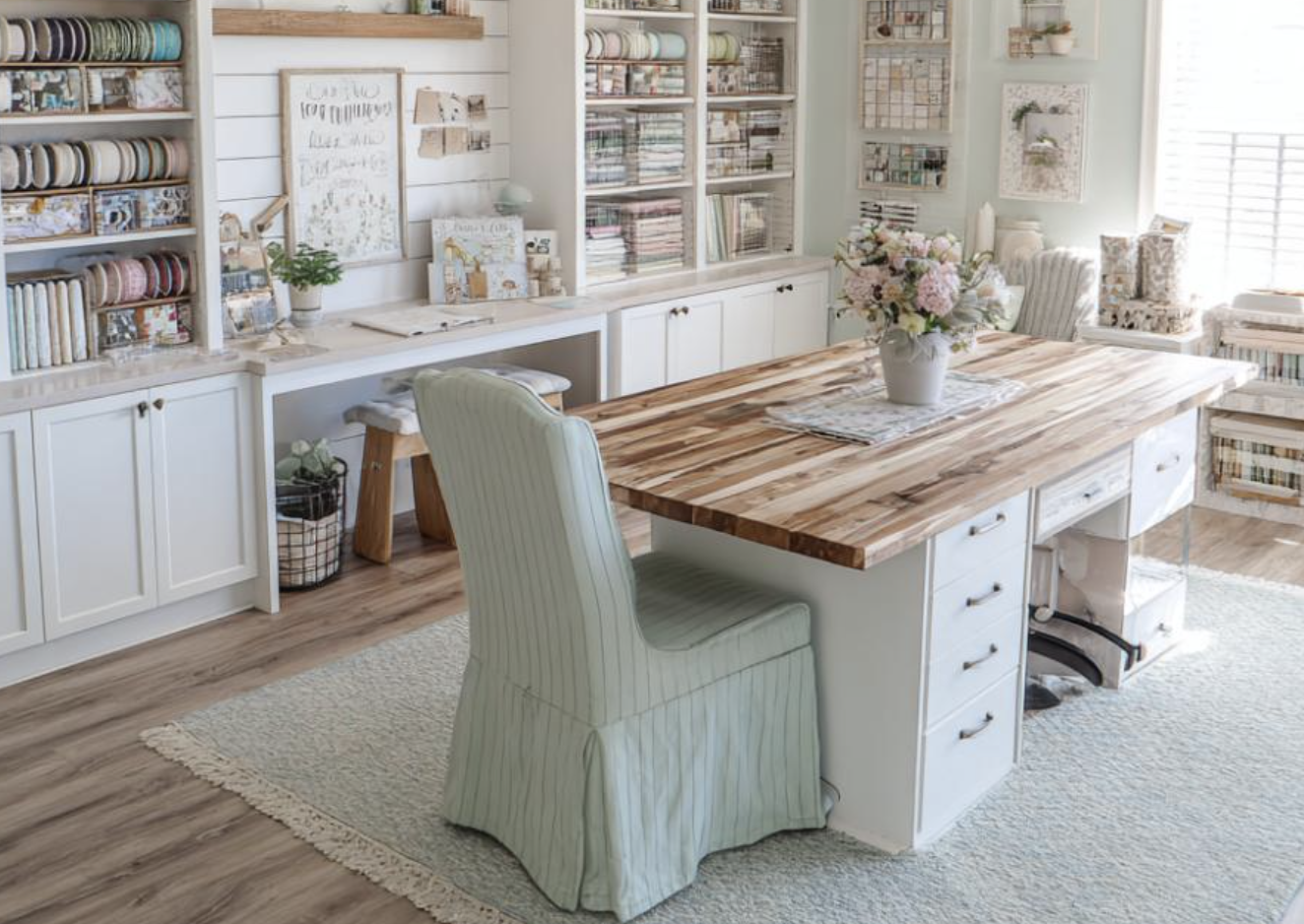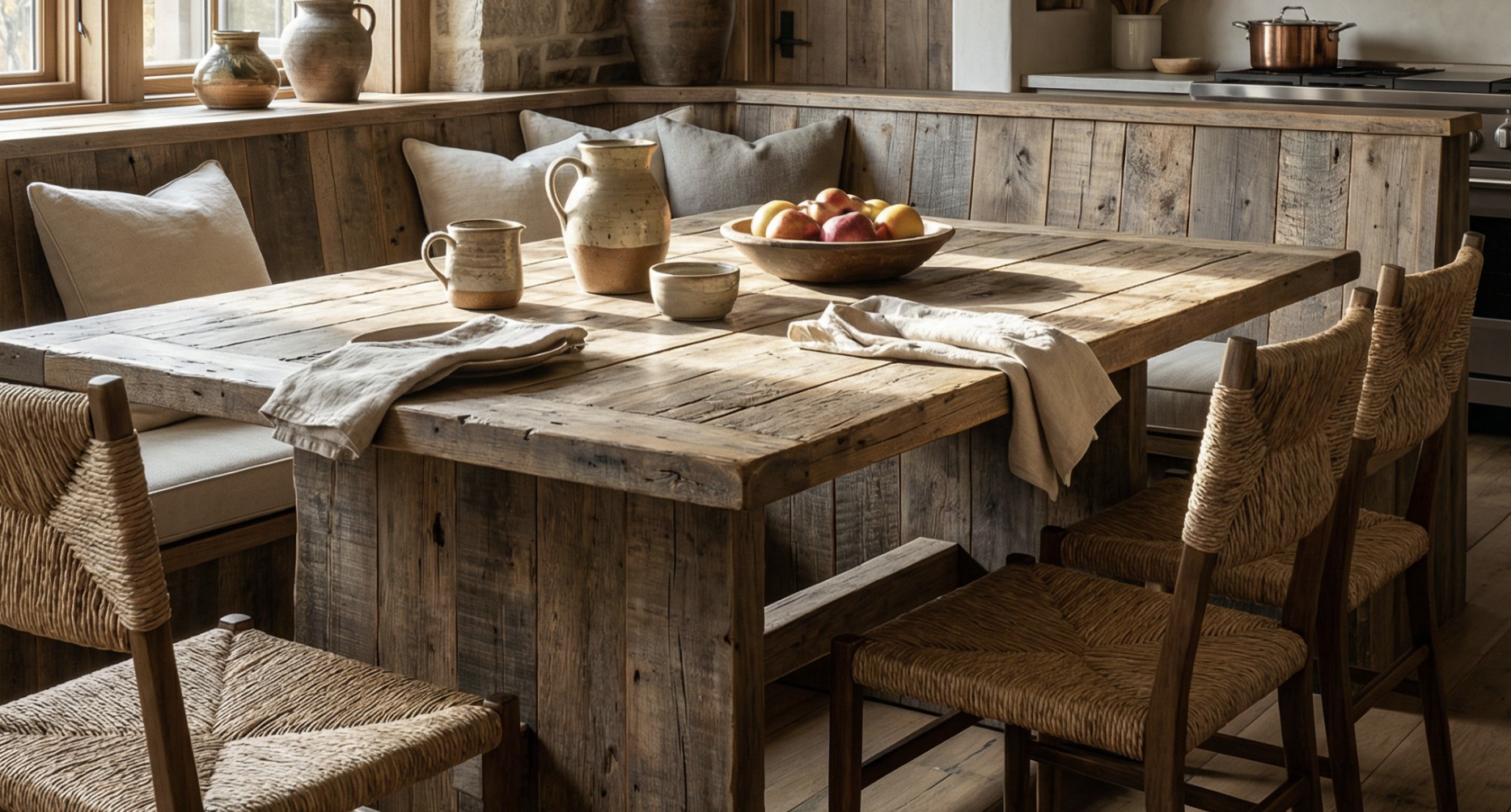
The kitchen island dining nook represents a brilliant fusion of functionality and intimacy, transforming what was once merely a workspace into the emotional heart of the home. These integrated seating solutions embody what I call “anchored gathering design”—spaces that create psychological safety through their enclosed nature while maintaining visual connection to the kitchen’s activity. Built-in nooks eliminate the awkward furniture placement dilemmas of traditional dining while maximizing every precious square foot, making them essential for modern living where homes serve multiple roles simultaneously.
In order to come up with the very specific design ideas, we create most designs with the assistance of state-of-the-art AI interior design software.
L-Shaped Kitchen Island Dining Nook Banquette
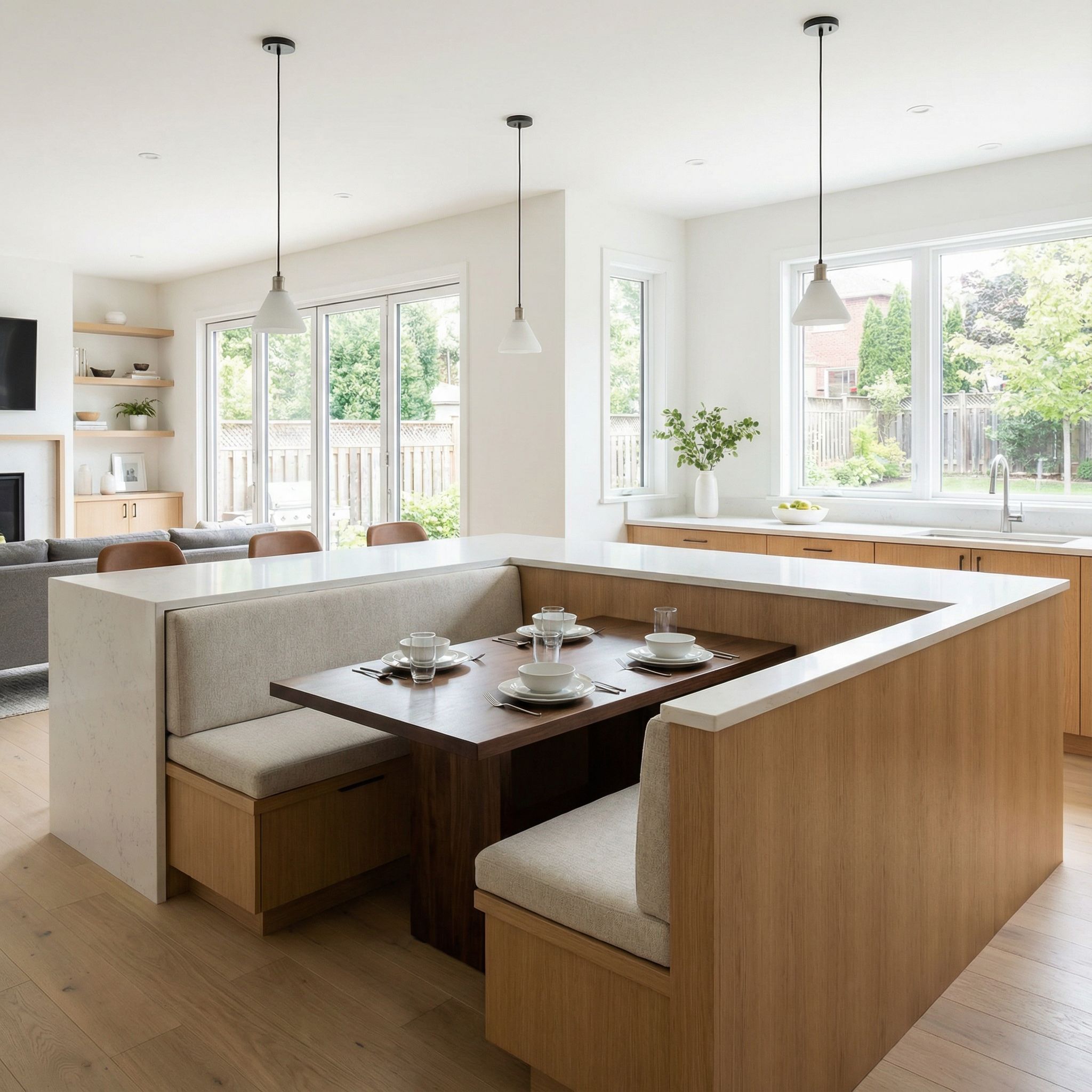
The L-shaped banquette creates what I term “conversational corners,” where two perpendicular seating walls naturally encourage face-to-face interaction. This configuration psychologically draws people together while providing back support on two sides, creating a cocoon-like comfort that makes lingering over coffee irresistible. The perpendicular orientation maximizes seating capacity without extending into traffic flow, making it ideal for kitchens where space efficiency determines livability and social dynamics.
Corner Kitchen Island Dining Nook with Storage
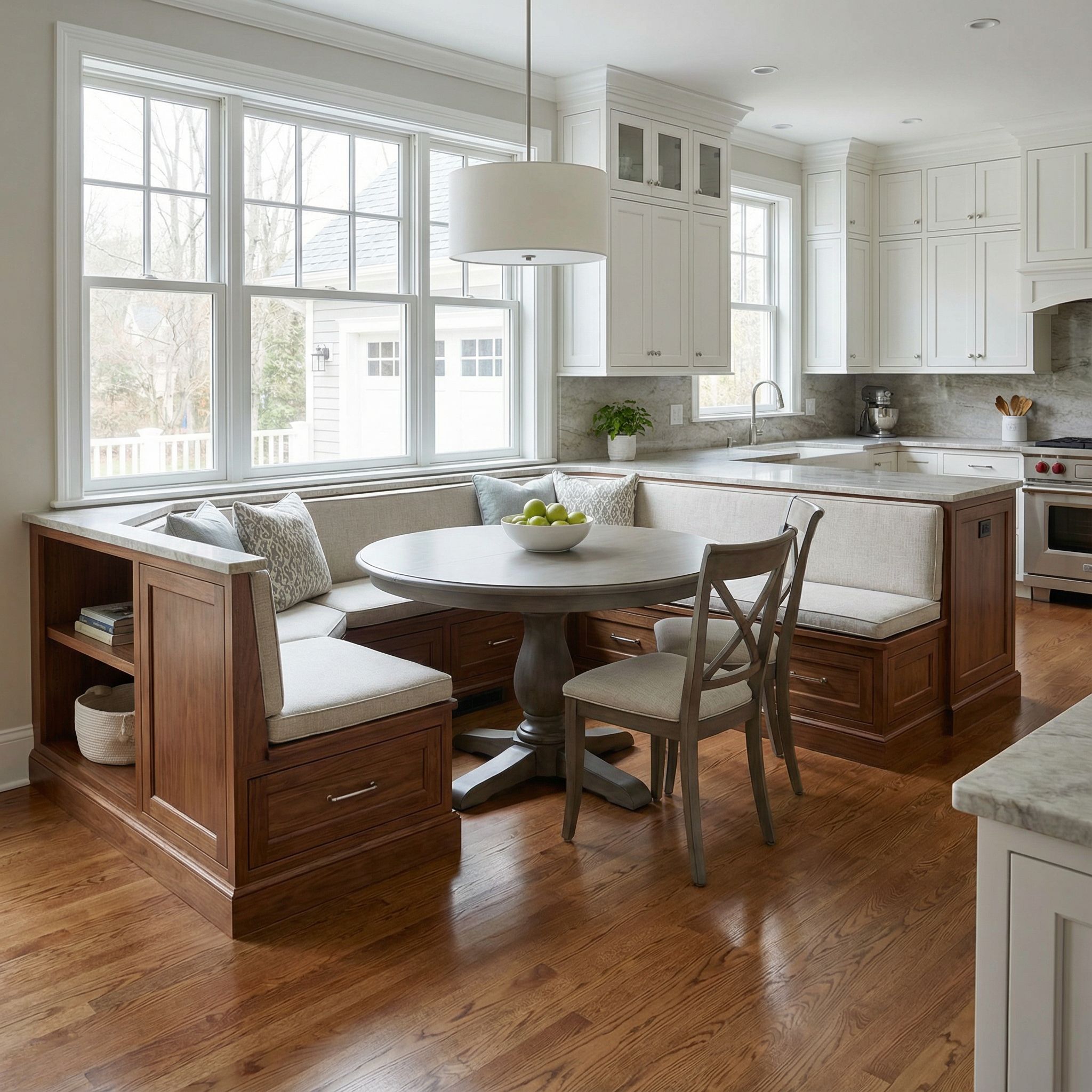
Corner nooks with integrated storage exemplify “dual-purpose design intelligence,” where every cubic inch earns its place through multiple functions. Lift-up bench seats reveal cavernous storage for seasonal dishware, linens, or small appliances, eliminating clutter anxiety while maintaining clean sightlines. This design addresses the modern homeowner’s perpetual storage crisis, transforming dead corner space into highly functional real estate that reduces kitchen chaos and mental load simultaneously.
Kitchen Island Dining Nook with Curved Seating

Curved seating introduces what I call “embrace geometry” into kitchen design, where rounded forms subconsciously communicate welcome and inclusion. The absence of sharp corners creates fluid traffic patterns and prevents the bruised hips that plague traditional rectangular islands. Psychologically, curves soften the kitchen’s utilitarian nature, introducing an organic, nurturing quality that makes the space feel less industrial and more human-centered, encouraging family members to gather naturally.
Two-Tier Kitchen Island Dining Nook Design
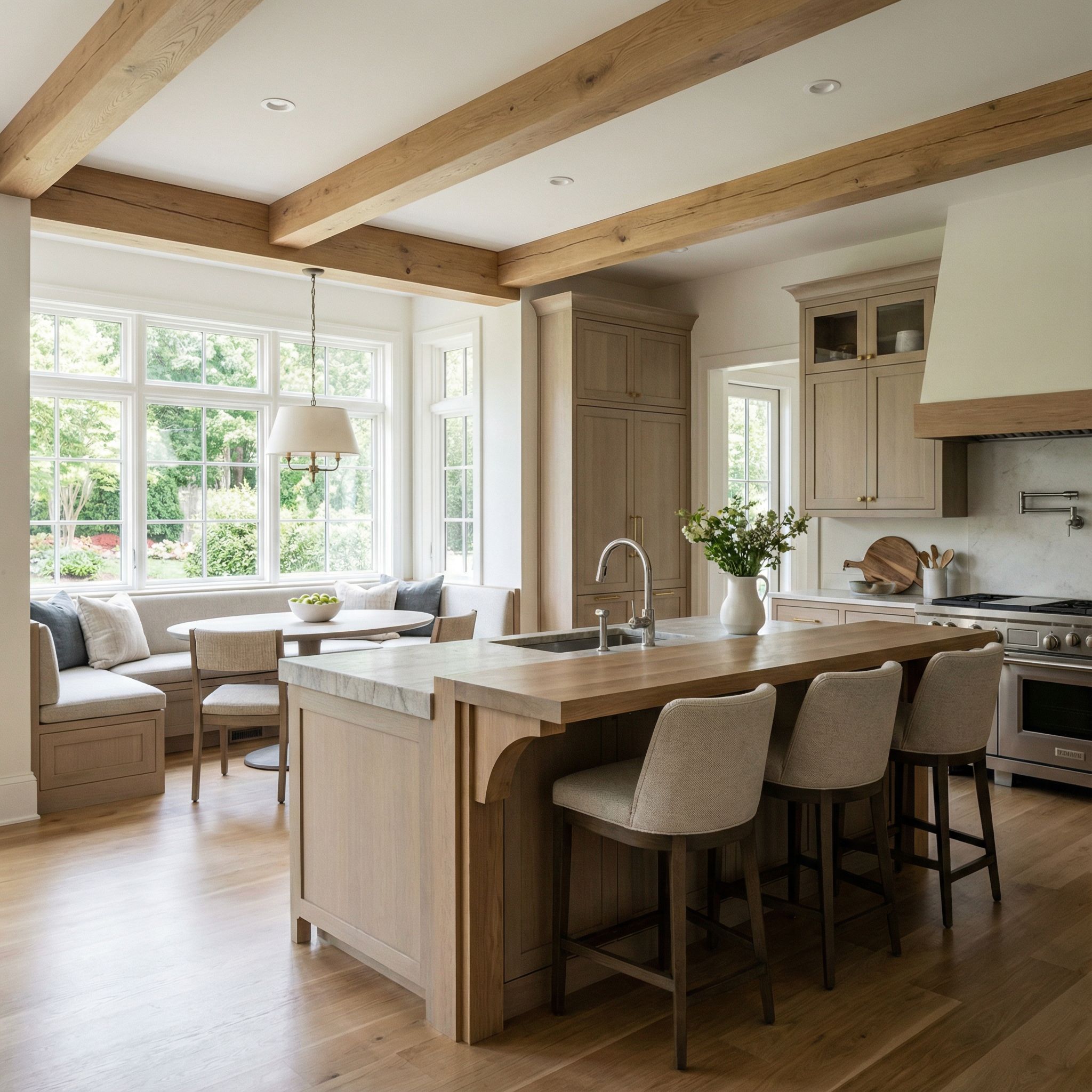
The two-tier island creates functional zones through elevation changes, establishing clear boundaries between food preparation and dining without physical barriers. The raised dining level conceals kitchen mess from seated guests while maintaining sightlines for the cook, satisfying our desire for connection without exposing culinary chaos. This vertical differentiation also addresses ergonomic needs, providing proper dining height while maintaining optimal counter workspace, demonstrating thoughtful attention to how bodies actually inhabit spaces.
Kitchen Island Dining Nook with Window Views

Positioning nook seating toward windows taps into our innate biophilic needs, connecting diners with natural light and outdoor views that reduce stress and enhance wellbeing. This orientation transforms mundane meals into restorative experiences, where breakfast becomes a moment of morning meditation rather than rushed refueling. Window-facing nooks also maximize natural illumination, reducing energy consumption while creating the sun-drenched ambiance that consistently tops homeowner wish lists across demographics and geographies.
Minimalist Kitchen Island Dining Nook with Bench
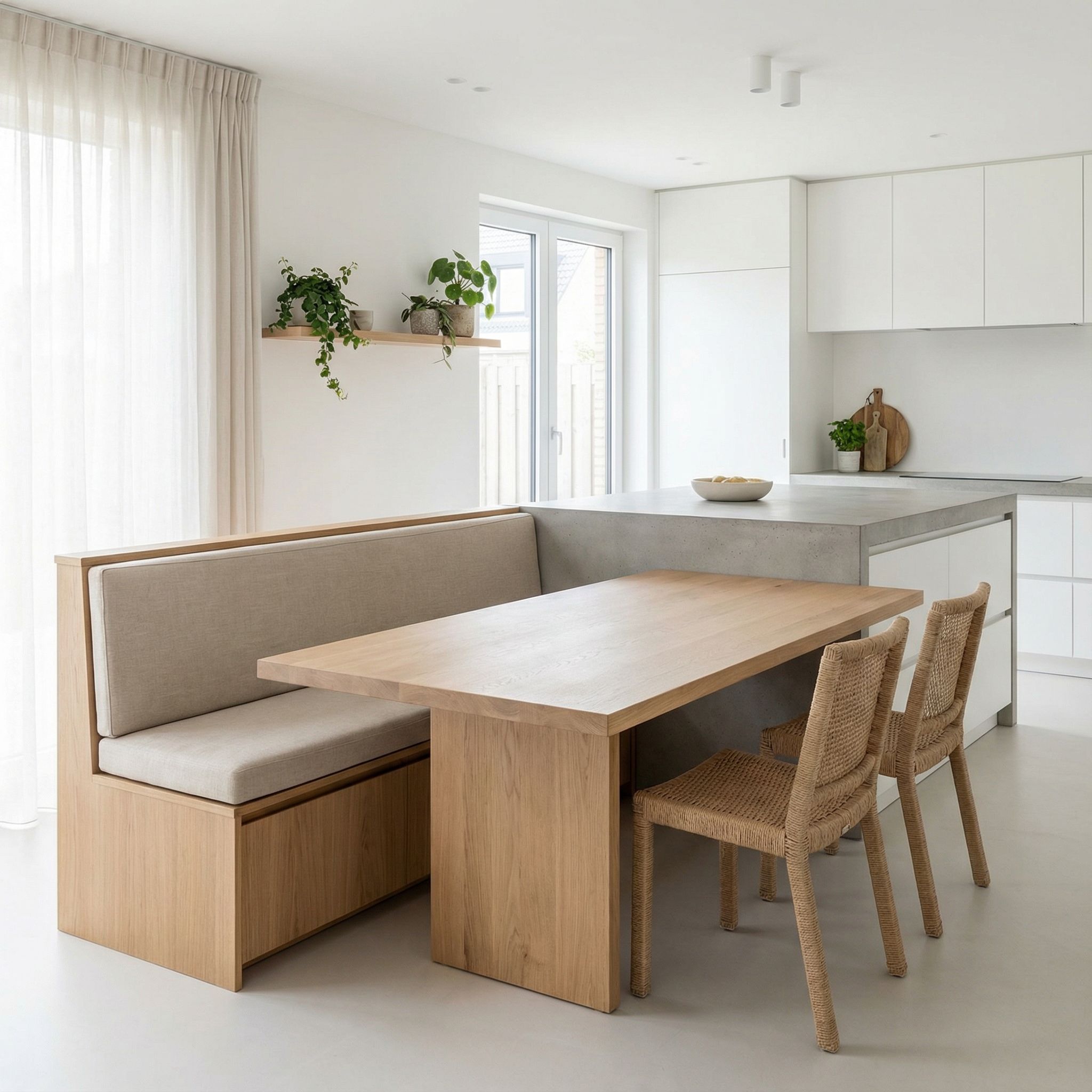
Minimalist nooks embody “essential comfort”—stripped of ornamentation yet deeply functional through considered proportions and quality materials. Clean-lined benches without visible hardware or excessive detailing create visual calm that counters modern life’s sensory overload. This restraint isn’t deprivation but intentional curation, allowing the eye to rest and the mind to decompress. The absence of clutter creates psychological spaciousness that makes even compact kitchens feel luxuriously unencumbered and breathable.
Kitchen Island Dining Nook with Upholstered Seating
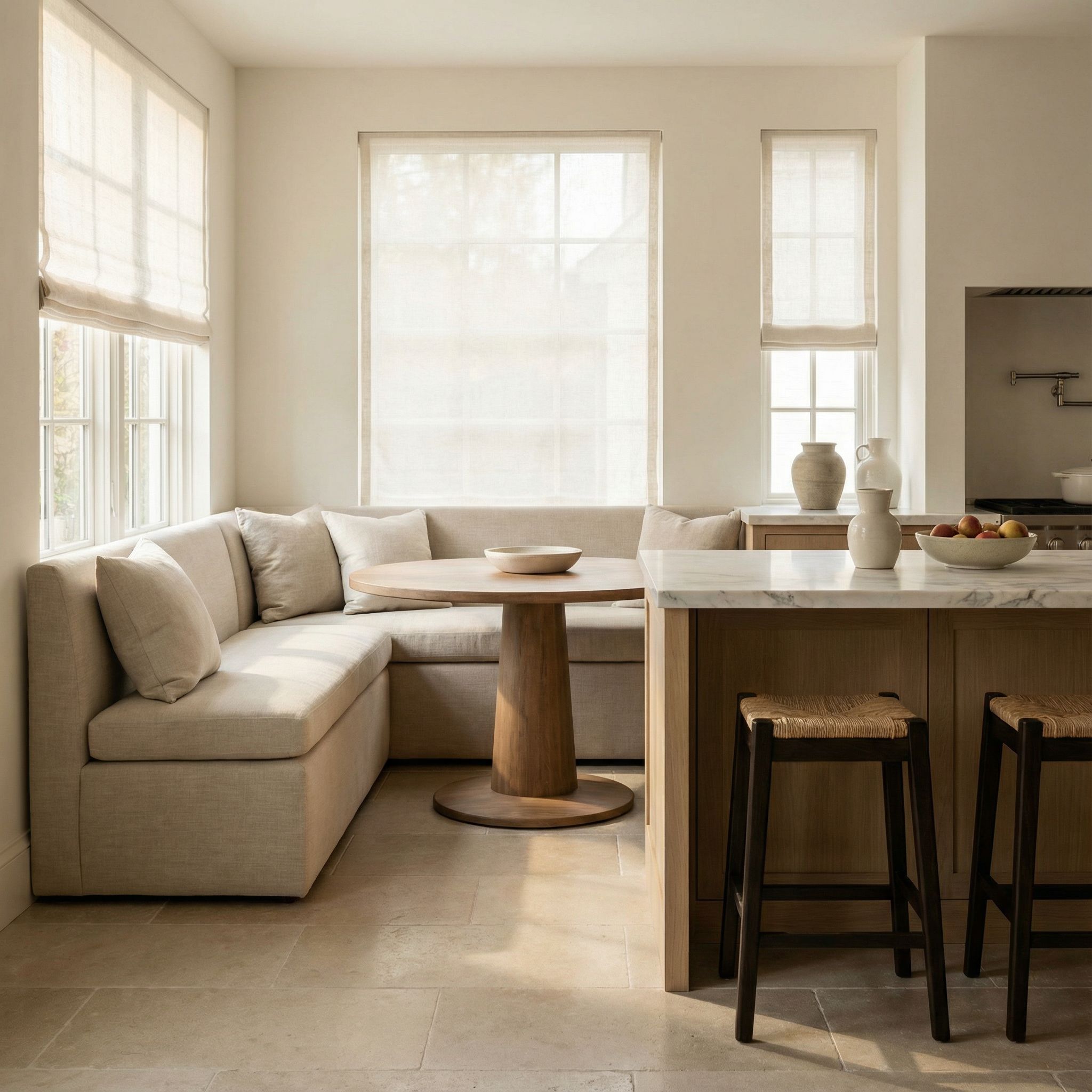
Upholstered seating introduces textile warmth that softens the kitchen’s typically hard surfaces of stone, steel, and tile. Cushioned benches signal leisure rather than utility, psychologically shifting the space from work zone to comfort zone. Performance fabrics now withstand kitchen life’s inevitable spills while providing the tactile pleasure that makes people want to settle in. This material choice transforms functional seating into inviting furniture, elevating the kitchen from service space to living space.
Rustic Kitchen Island Dining Nook with Reclaimed Wood
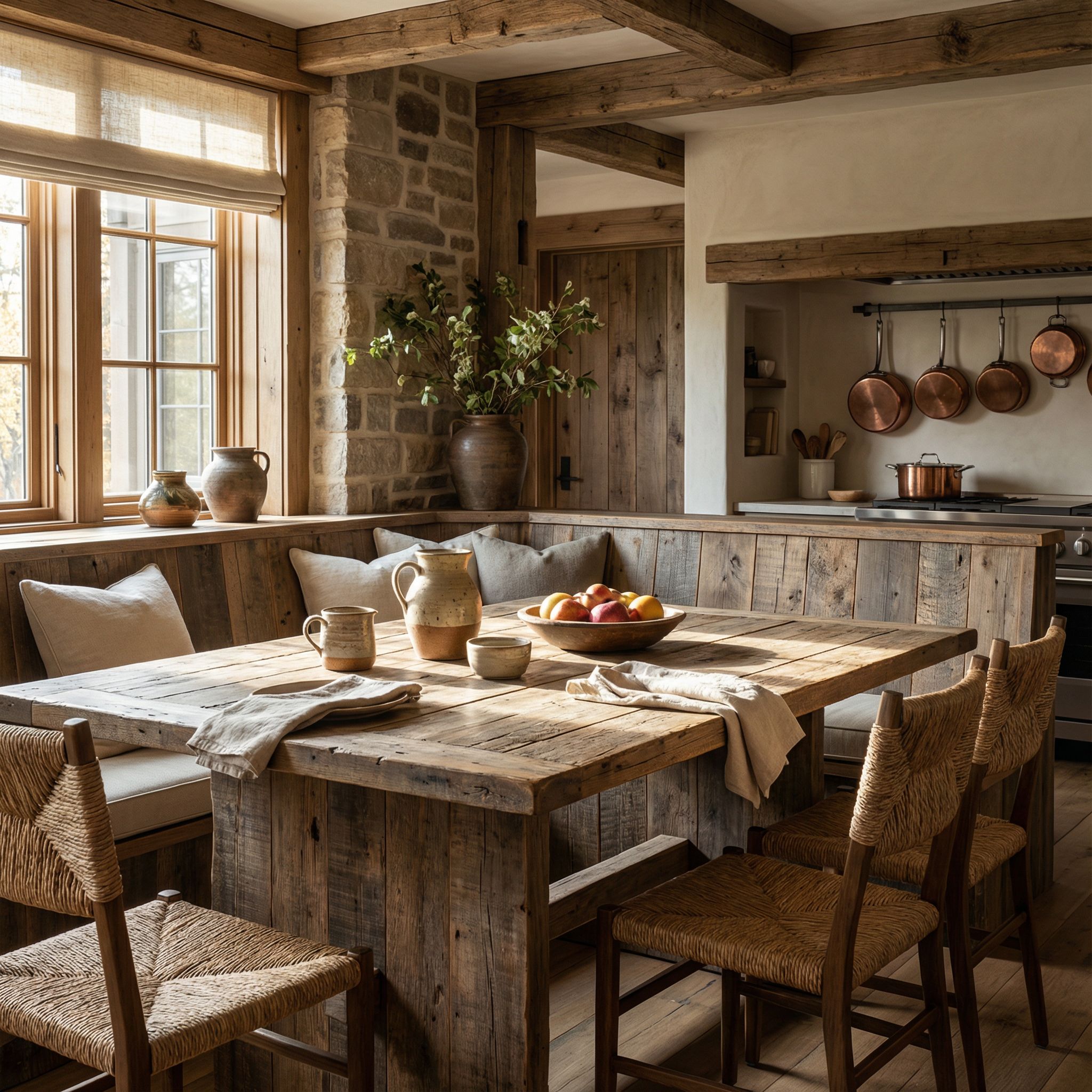
Reclaimed wood nooks tell stories through weathered grain and aged patina, introducing what I call “temporal texture”—the visual evidence of time passing that grounds us in continuity. These imperfect surfaces counter modern life’s digital smoothness, providing tactile authenticity that satisfies our hunger for genuine materials. Rustic elements create emotional warmth through their handcrafted irregularity, making industrially-produced kitchens feel more personal, lived-in, and connected to craft traditions that predate mass manufacturing.
Modern Kitchen Island Dining Nook with Pendant Lighting
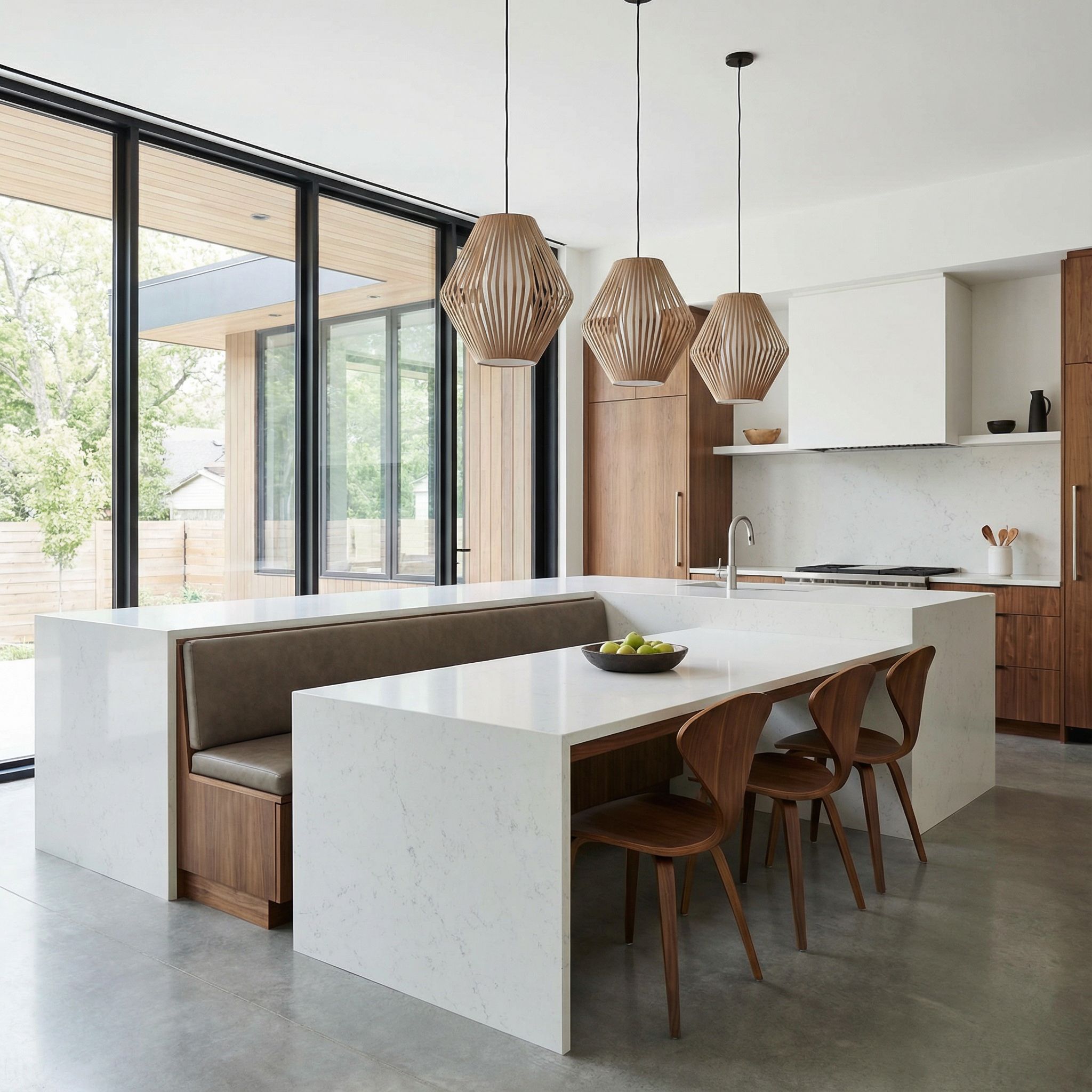
Statement pendant lighting transforms nook seating into a defined destination, using illumination to psychologically separate dining from cooking zones. Suspended fixtures at varied heights create layered lighting that’s both functional and atmospheric, allowing dimming for intimate dinners or brightening for homework sessions. This vertical design element draws the eye upward, making ceilings feel taller while establishing the nook as an intentional gathering spot rather than leftover space, demonstrating lighting’s power to define purpose.
Kitchen Island Dining Nook with Built-In Bookshelves
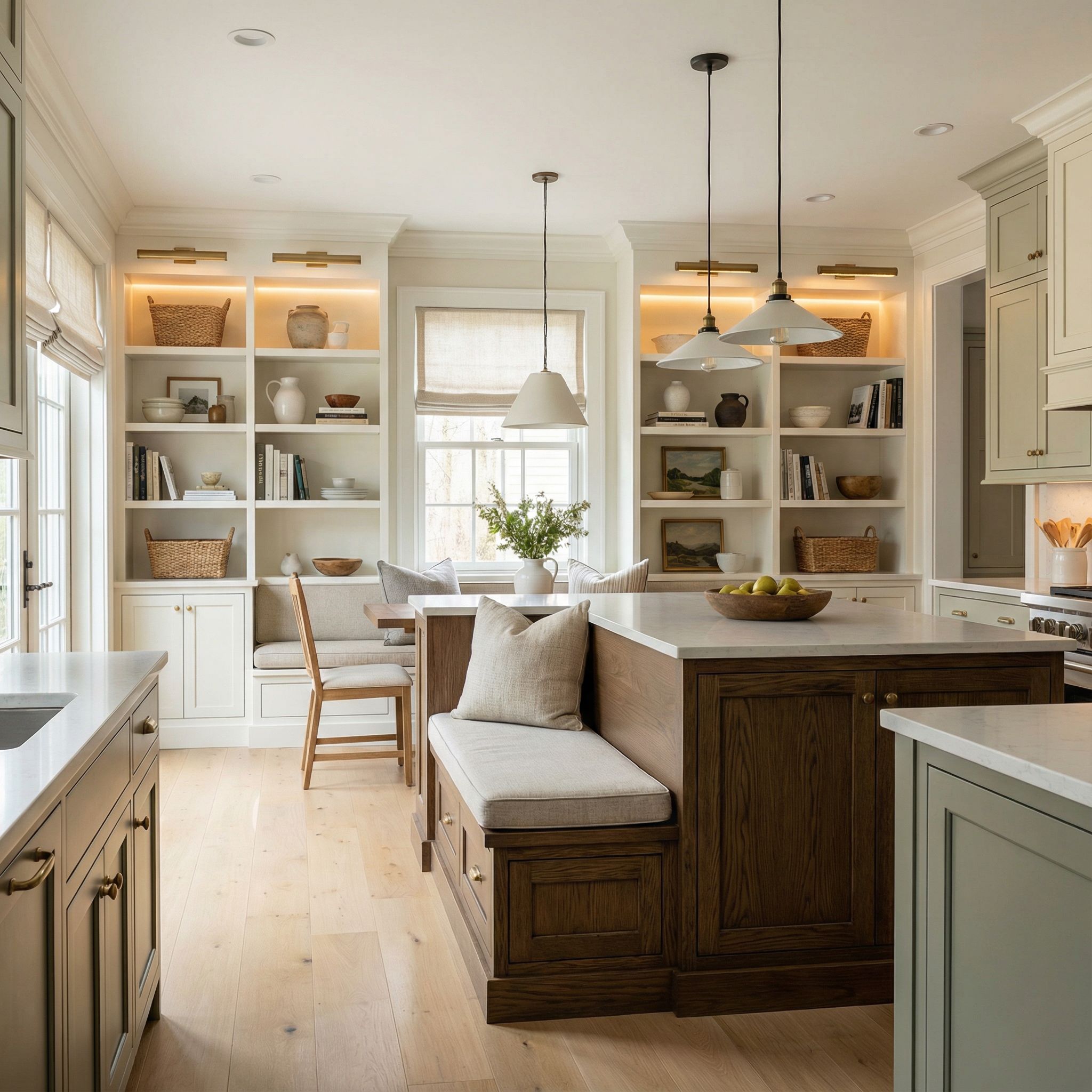
Integrated bookshelves surrounding nook seating create what I term “intellectual comfort,” where reading materials within arm’s reach encourage lingering and learning. This design acknowledges that kitchens increasingly serve as homework stations, recipe research centers, and casual reading spots. Open shelving displays cookbooks and family photos, personalizing the space while keeping frequently referenced materials accessible. The library aesthetic elevates casual dining into cultured living, satisfying our desire for spaces that nurture multiple dimensions of daily life.
Coastal Kitchen Island Dining Nook with Light Wood

Light wood nooks in pale oak, ash, or whitewashed finishes evoke seaside serenity through their sun-bleached appearance and organic grain patterns. These airy tones maximize light reflection, making kitchens feel larger and more open while introducing natural warmth without visual heaviness. The coastal aesthetic taps into vacation memories and relaxation associations, transforming everyday dining into a perpetual escape. Blonde woods pair beautifully with whites and blues, creating cohesive color stories that feel effortlessly breezy.
Kitchen Island Dining Nook with Booth-Style Seating

Booth-style nooks channel nostalgic diner aesthetics while providing practical advantages like defined personal space and efficient seating density. High-backed booths offer acoustic privacy in open-plan homes, dampening kitchen noise and creating intimate conversation pockets. This configuration psychologically separates diners from surrounding activity, allowing focused meals without distraction. The retro reference point introduces playful personality while meeting contemporary needs for flexible, space-efficient seating that accommodates varying group sizes throughout daily life.
Transitional Kitchen Island Dining Nook with Neutral Tones
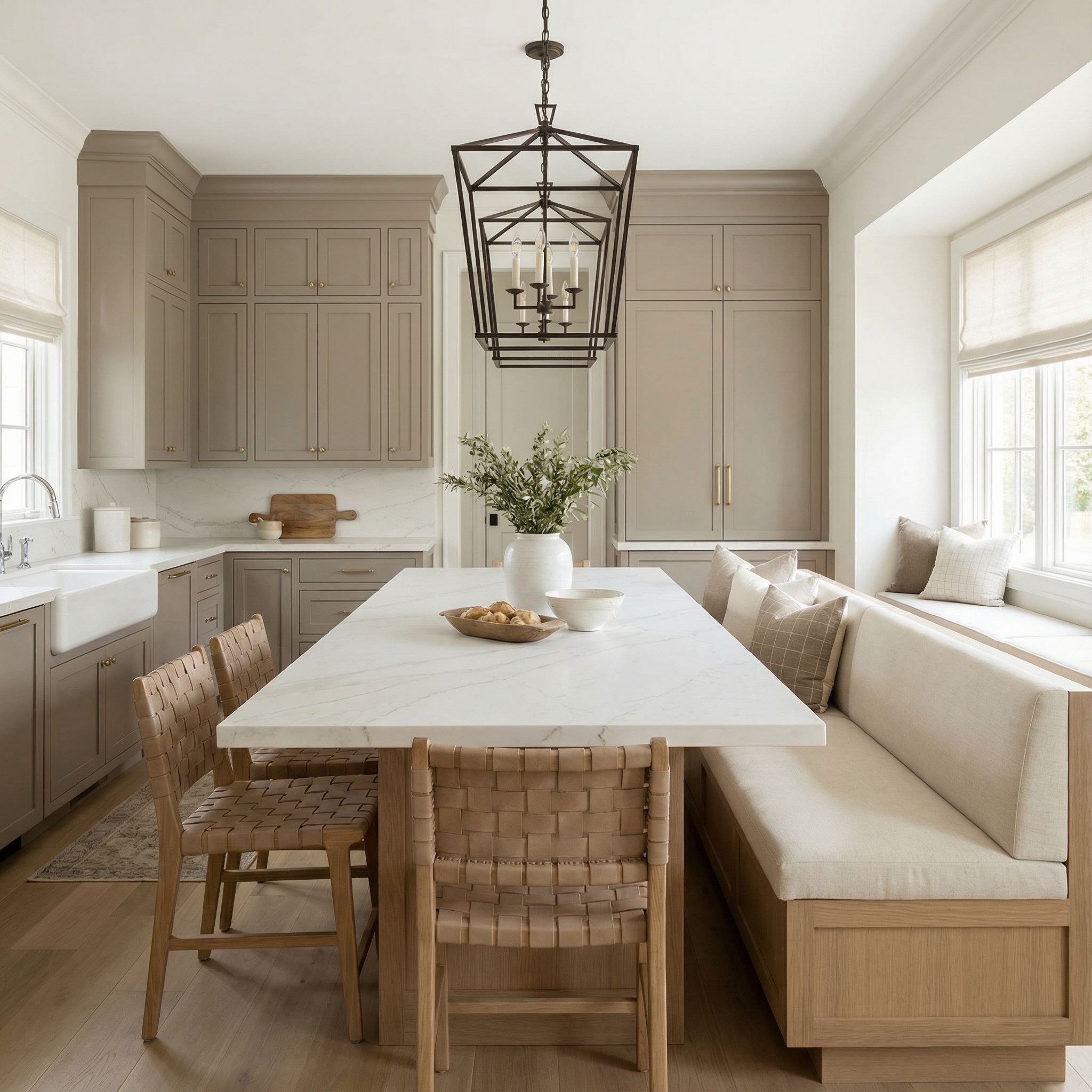
Transitional nooks balance traditional comfort with contemporary simplicity through neutral palettes and hybrid detailing that reads as timelessly elegant. Grays, taupes, and greiges create sophisticated backdrops that accommodate changing décor whims without requiring renovation. This style embodies “design diplomacy,” appealing to diverse aesthetic preferences within households while maintaining cohesion. Neutral nooks age gracefully, avoiding trendy elements that quickly date, making them wise investments for homeowners prioritizing longevity over momentary fashion in their foundational design choices.
Kitchen Island Dining Nook with Breakfast Bar Extension
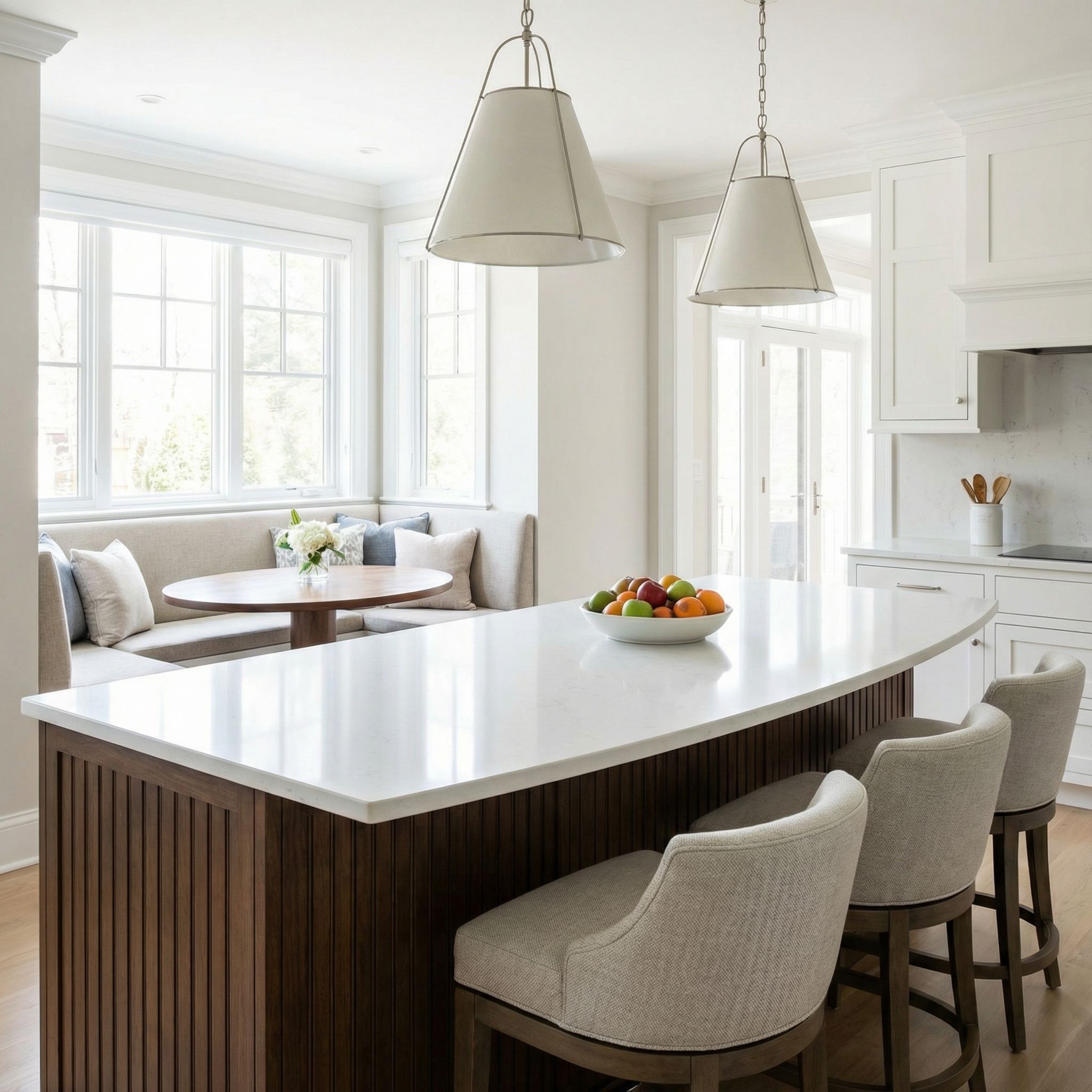
Breakfast bar extensions create flexible seating capacity, accommodating intimate family meals and larger gatherings without furniture rearrangement. The cantilevered counter provides casual perching spots that don’t require built-in commitment, appealing to different sitting preferences and social comfort levels. This hybrid approach satisfies our need for both defined nook coziness and open accessibility, allowing introverts their anchored corner while extroverts claim bar stools, demonstrating how thoughtful design accommodates diverse personality types within single spaces.
Farmhouse Kitchen Island Dining Nook with Shiplap
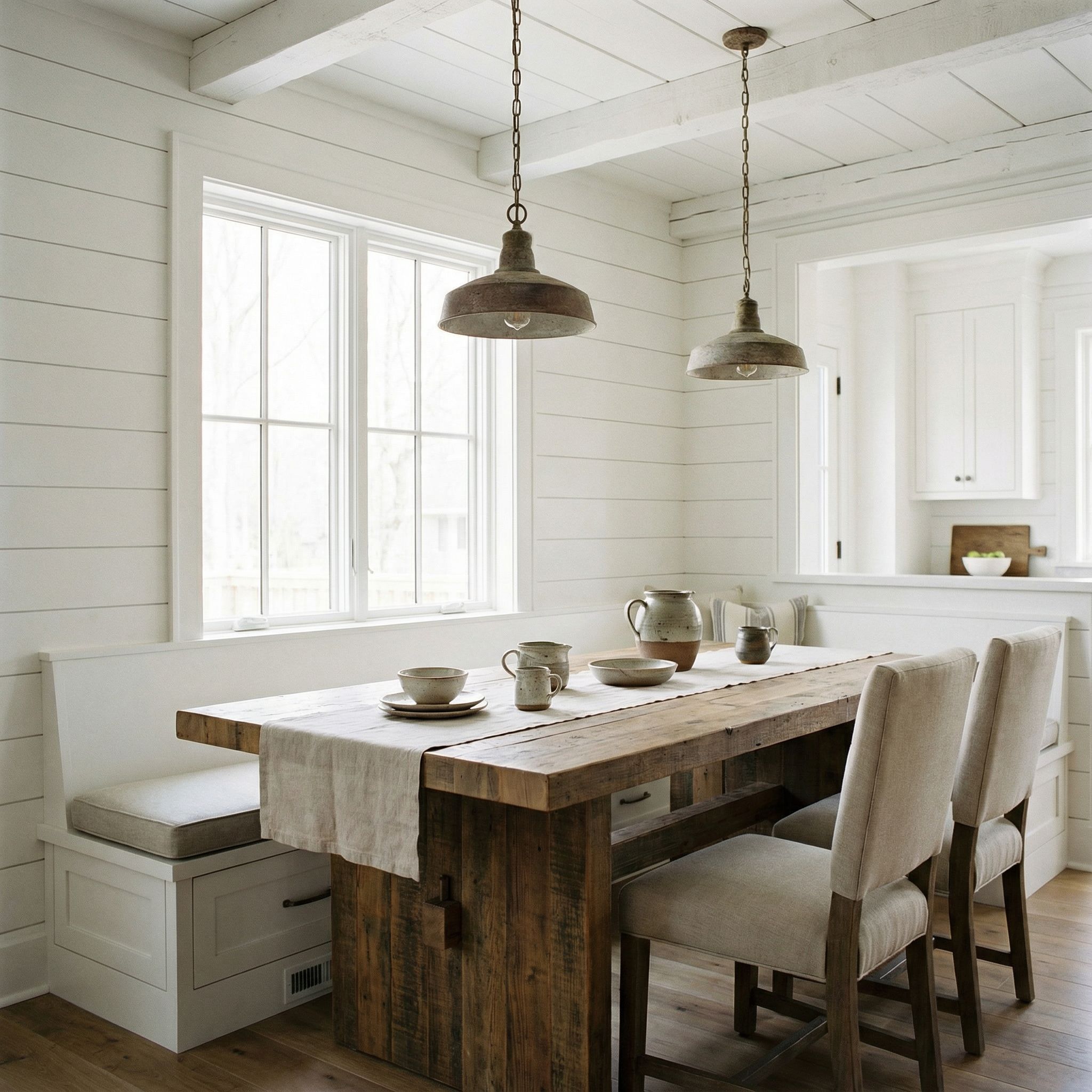
Shiplap-clad nooks introduce horizontal line rhythm that visually expands spaces while adding farmhouse character through texture rather than color. The grooved boards create dimensional interest that catches light beautifully, adding depth to what might otherwise be flat walls. This detail channels agrarian simplicity and handcrafted quality, satisfying contemporary cravings for authenticity in increasingly automated lives. Painted white, shiplap brightens while maintaining subtle texture; left natural, it introduces warmth without overwhelming compact spaces with heavy visual weight.
Kitchen Island Dining Nook with Tufted Cushions

Tufted cushions introduce luxury detailing typically reserved for formal living spaces, elevating kitchen seating from utilitarian to indulgent. The button-quilted texture adds visual interest and tactile pleasure while providing ergonomic support that encourages extended sitting. This upholstery choice signals that the kitchen deserves the same design attention as public rooms, reflecting how these spaces now function as primary living areas. Tufting creates a jewel-box quality that makes everyday meals feel special, demonstrating design’s power to elevate routine experiences.
Open-Concept Kitchen Island Dining Nook with Stools
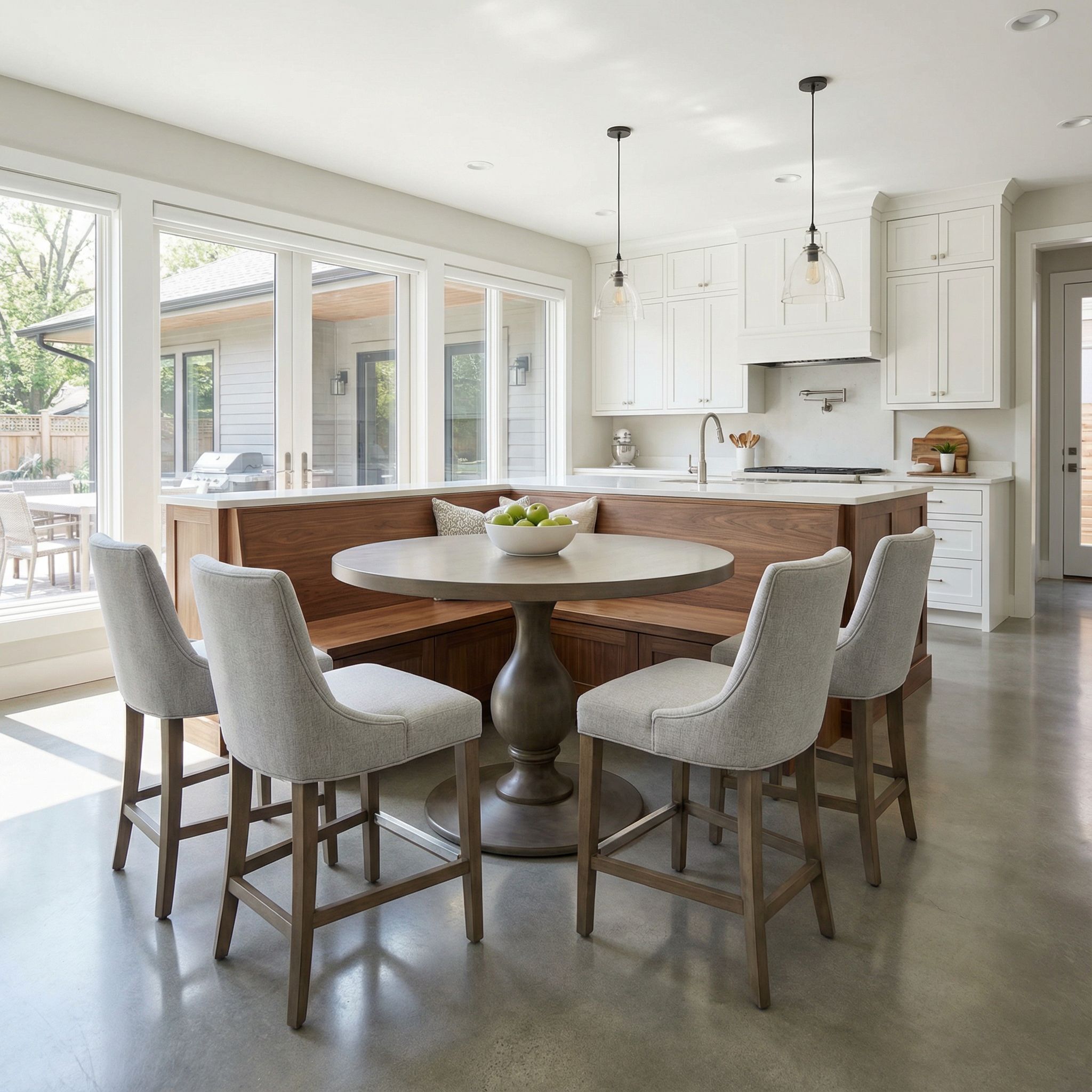
Combining built-in nook seating with adjacent bar stools creates diverse seating options that accommodate different activities and social configurations simultaneously. Stools offer quick perching for coffee or conversation without the commitment of settling into the nook, while built-in seating provides anchored comfort for lingering meals. This variety acknowledges that families inhabit kitchens differently throughout the day, requiring adaptable furniture that supports multiple use patterns without appearing cluttered or indecisive in its design intention.
Kitchen Island Dining Nook with Marble Countertops
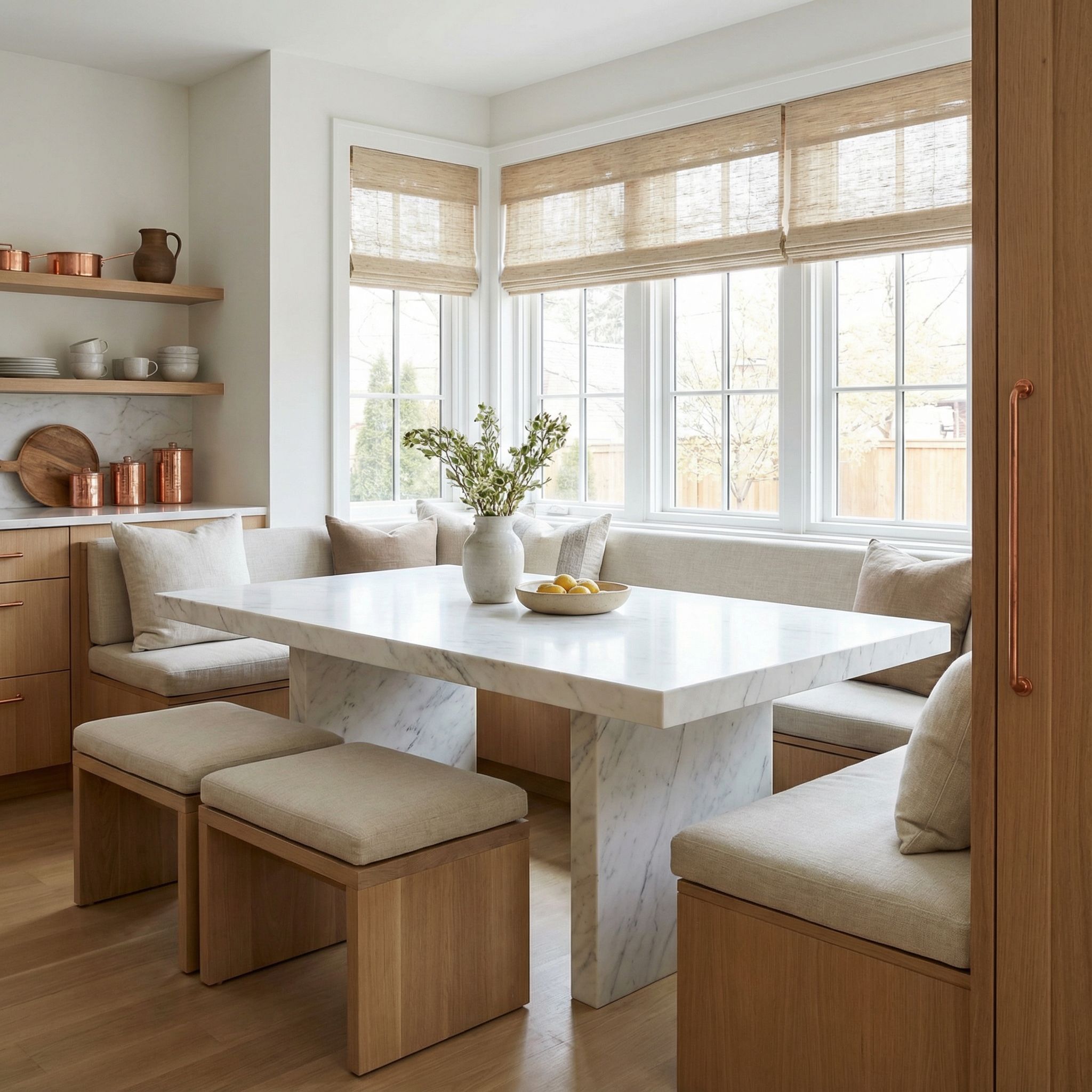
Marble countertops introduce geological luxury and cooling properties that feel refreshing in warm kitchens while providing durable surfaces for meal service. The stone’s natural veining creates organic artwork that never repeats, satisfying our appreciation for uniqueness in mass-produced environments. Marble’s cool touch and smooth finish appeal to our tactile senses, while its historical associations with classical architecture lend gravitas and permanence. Though requiring maintenance, marble signals investment in quality materials that age beautifully, developing character rather than merely deteriorating.
Small Kitchen Island Dining Nook Space-Saving Solution

Compact nooks demonstrate that intimacy improves as square footage decreases, creating cozy gathering spots in kitchens where traditional tables won’t fit. Built-in seating eliminates chair clearance requirements, reclaiming circulation space for actual sitting capacity. These efficient solutions prove that constraint breeds creativity, forcing designers to maximize every dimension through clever storage, fold-down tables, and multifunctional elements. Small nooks feel snug rather than cramped when proportioned correctly, offering refuge-like comfort that large spaces struggle to achieve psychologically.
Kitchen Island Dining Nook with Contrasting Colors

Bold color contrasts between nook seating and surrounding cabinetry create visual focal points that establish hierarchy and interest within open kitchens. A navy nook against white cabinets or emerald seating beside gray counters draws the eye intentionally, defining zones through chromatic differentiation rather than physical barriers. This approach introduces personality and playfulness while maintaining cohesion through repeated accent colors in accessories. Contrast satisfies our need for visual stimulation and variety, preventing the monotony that plagues single-color kitchen schemes lacking dimensional interest.
Industrial Kitchen Island Dining Nook with Metal Accents

Metal accents like steel brackets, iron pipe legs, or aluminum trim introduce industrial edge that balances organic wood warmth with urban toughness. These utilitarian elements reference warehouse conversions and factory aesthetics that celebrate raw materiality over refined polish. Metal’s cool tones and reflective surfaces add visual texture while conveying durability and low-maintenance practicality. The industrial vocabulary appeals to those seeking authenticity through honest materials that don’t pretend to be anything beyond their fundamental nature, creating spaces that feel grounded and real.
Kitchen Island Dining Nook with Leather Bench Seating
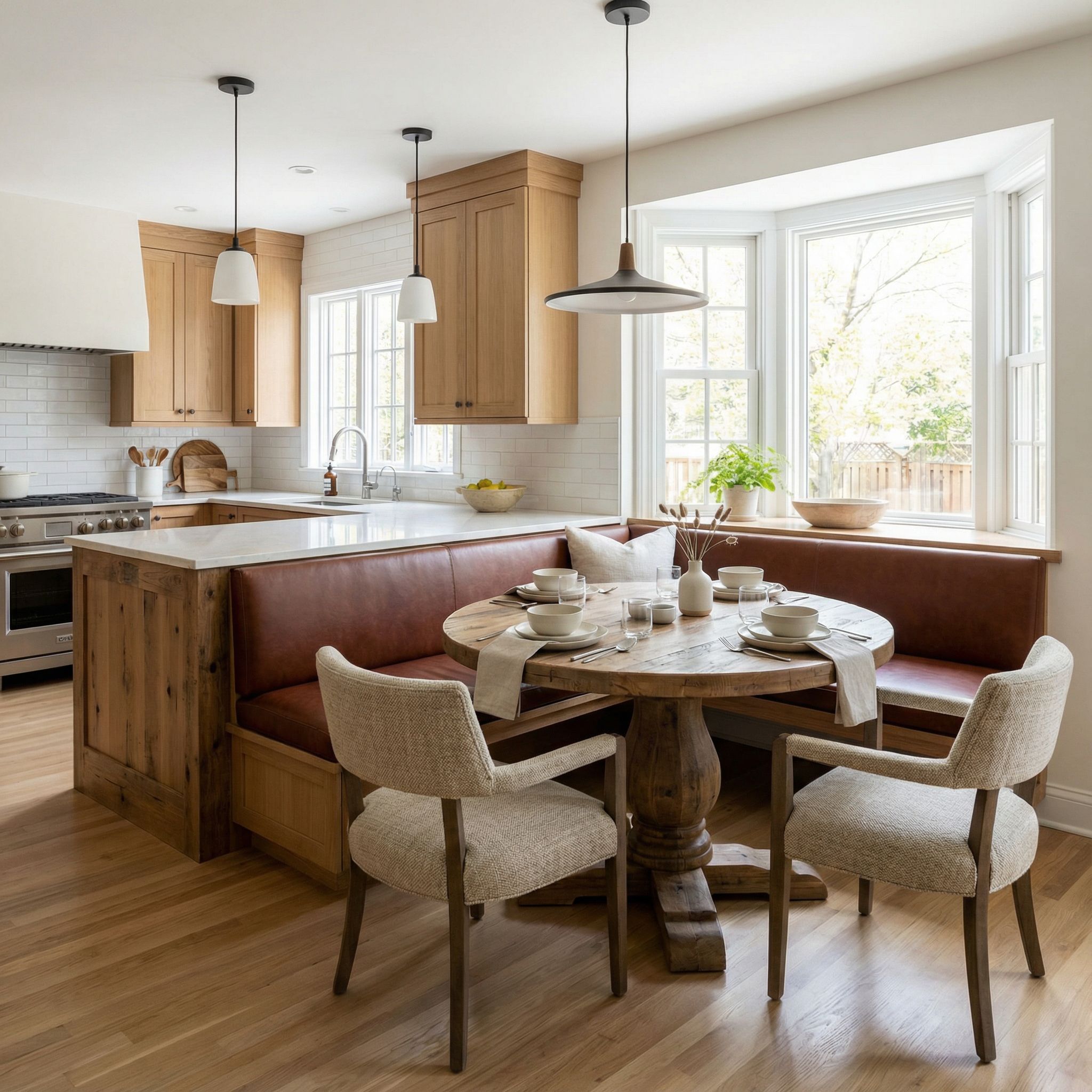
Leather seating introduces sophisticated, wipe-clean practicality with upscale lounge aesthetics that transform kitchen nooks into club-like retreats. The material’s natural texture and rich depth create warmth while developing a lived-in patina that improves with age, unlike fabrics that merely fade. Leather’s tactile quality and slight coolness feel luxurious against skin, elevating everyday seating into sensory experiences. This choice signals adult spaces where durability meets elegance, proving that family-friendly materials needn’t sacrifice style for function in contemporary kitchen design.
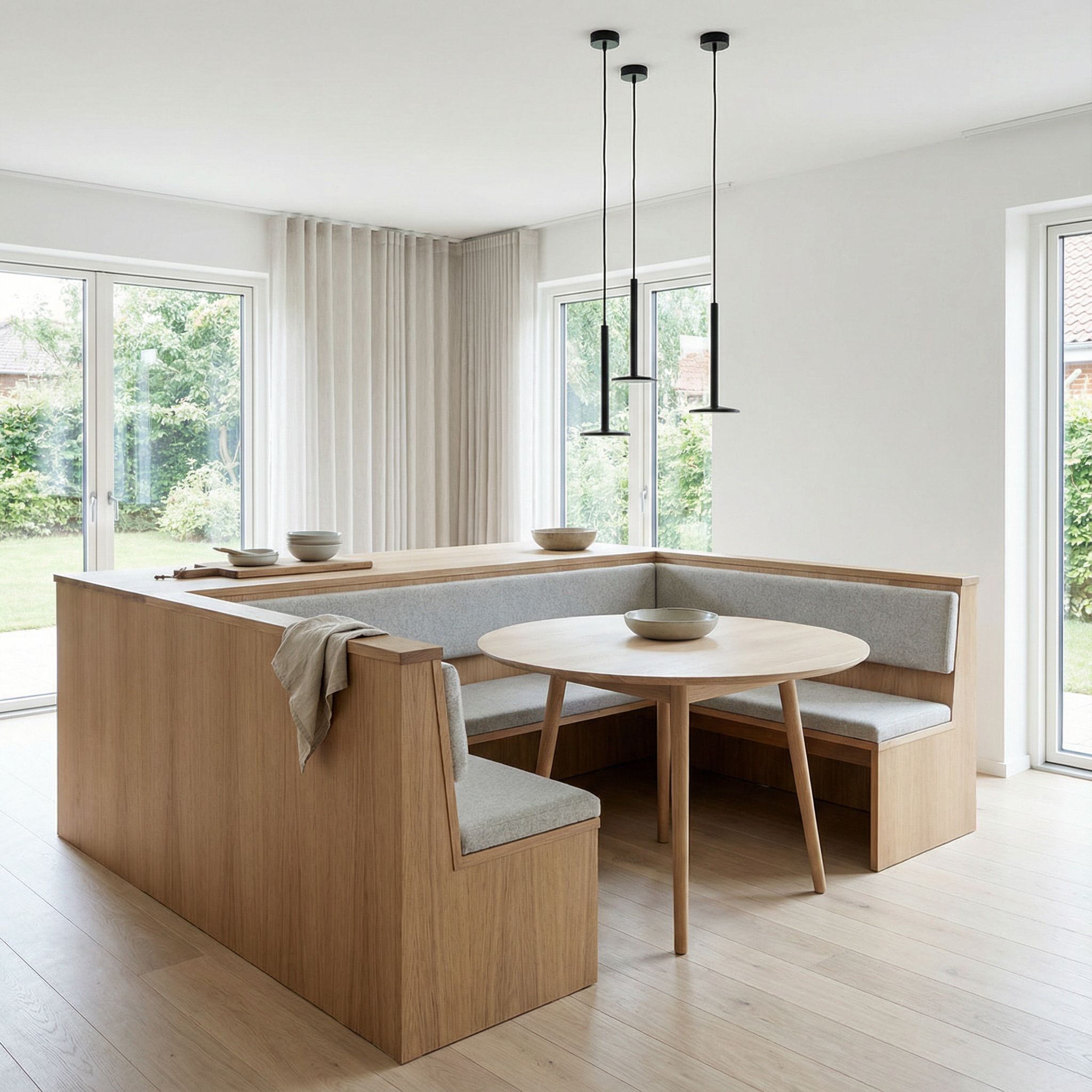
Scandinavian-inspired nooks embody functional minimalism through pale woods, simple geometries, and uncluttered surfaces that create serene dining environments. This aesthetic prioritizes light, both natural and artificial, understanding that Nordic countries combat darkness through reflective surfaces and strategic illumination. The design philosophy values quality over quantity, choosing fewer perfect pieces rather than abundant decoration. Clean lines reduce visual noise, allowing minds to rest while bodies refuel, creating psychologically restorative spaces that support wellbeing through intentional simplicity and environmental harmony.
Kitchen Island Dining Nook with Hidden Storage Drawers
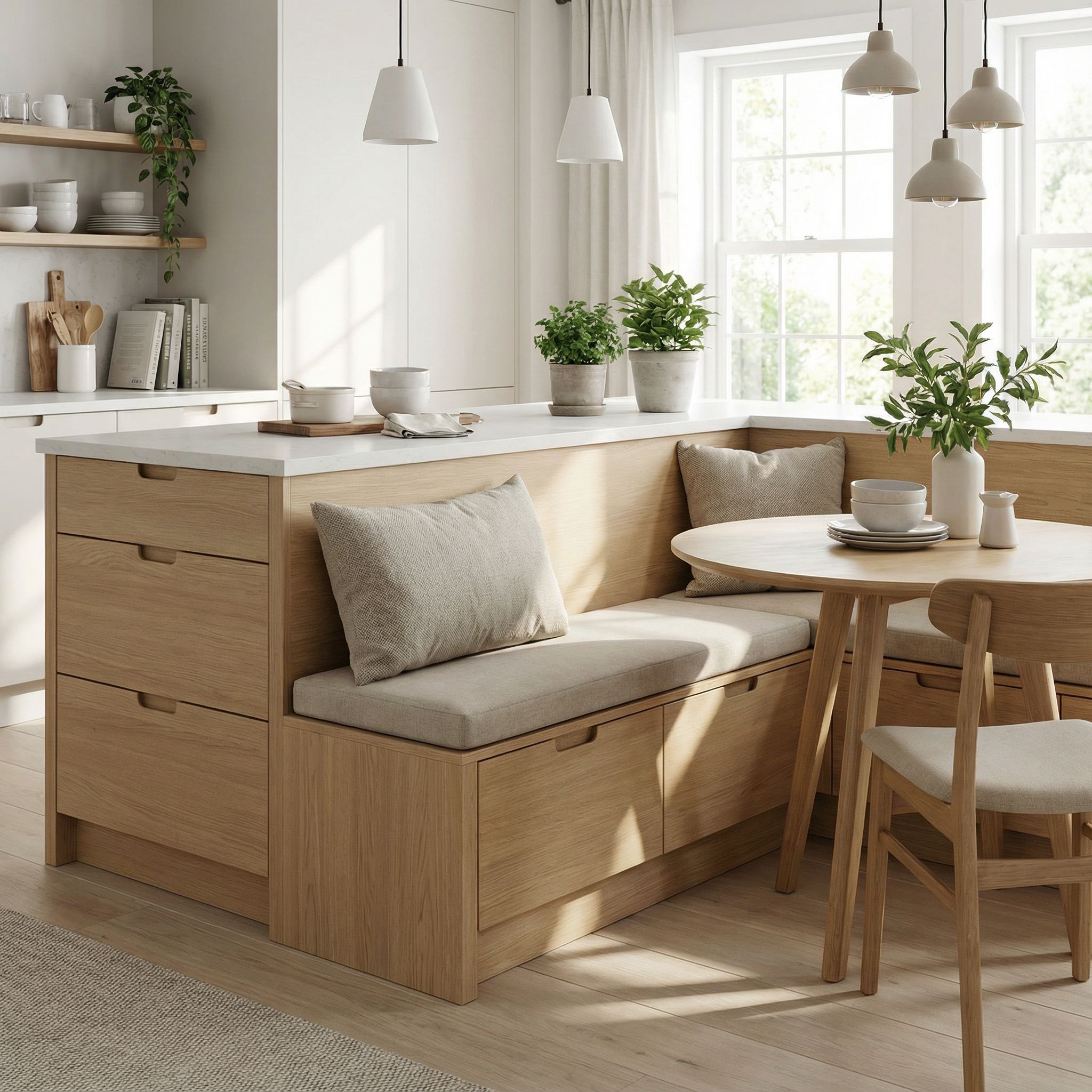
Hidden drawers beneath bench seating maximize storage without visual clutter, maintaining clean nook aesthetics while solving practical organizational challenges. Toe-kick drawers, side-mounted units, and under-seat compartments transform every available inch into functional space. This concealed approach satisfies our desire for order without the visual weight of open shelving, keeping necessary items accessible while maintaining minimalist appearances. Smart storage reduces decision fatigue by establishing dedicated homes for items, streamlining kitchen workflows and reducing the mental load of managing household inventory.
Traditional Kitchen Island Dining Nook with Wood Paneling

Wood paneling creates architectural substance and historical resonance, referencing classical design traditions that convey permanence and craftsmanship. Raised panels, beadboard, or wainscoting add dimensional detail that distinguishes custom-built nooks from simple benches, signaling investment in quality construction. Traditional detailing provides visual richness that ages gracefully, avoiding trendy elements that quickly date. This approach appeals to those seeking timeless elegance and connection to design heritage, creating kitchens that feel rooted in tradition while accommodating contemporary life’s functional requirements through updated spatial planning.
Kitchen Island Dining Nook with Wraparound Seating

Wraparound seating maximizes capacity while creating enclosed gathering spaces that psychologically center families within the kitchen’s activity. The continuous bench eliminates hierarchical head-of-table positioning, promoting egalitarian interaction where everyone enjoys equal status and visibility. This configuration works beautifully in open-plan homes, establishing defined zones without walls while maintaining visual connection across spaces. Wraparound designs feel embracing and inclusive, physically drawing people together in ways that promote conversation, connection, and the lingering togetherness that builds family culture and shared memories.
Contemporary Kitchen Island Dining Nook with Waterfall Edge
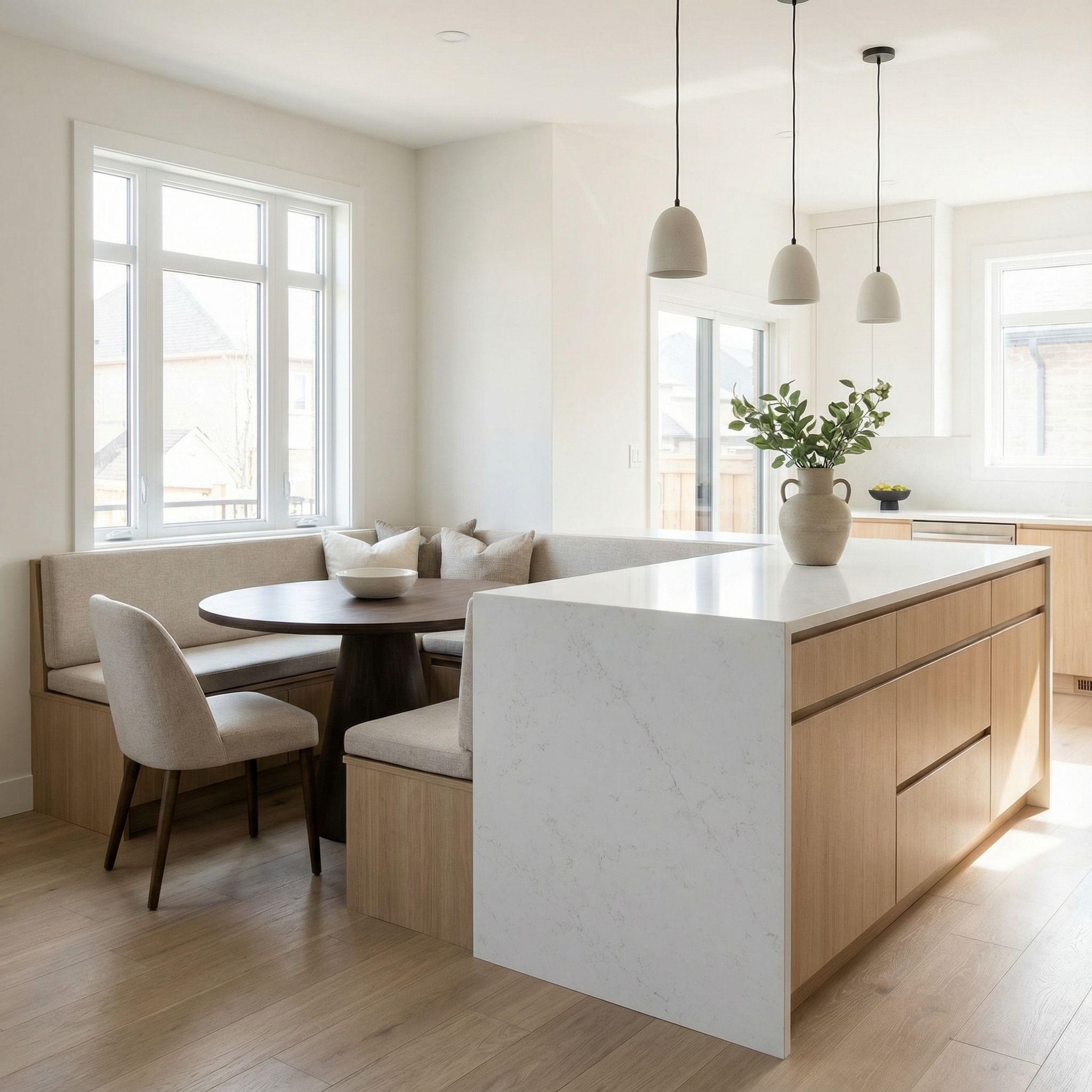
Waterfall edge countertops where stone cascades vertically to the floor create dramatic focal points and sculptural continuity that elevates islands from functional to artistic. The seamless material flow demonstrates skilled fabrication while protecting island ends from damage and concealing structural elements. This detail choice signals design sophistication and material investment, transforming utilitarian surfaces into statement pieces. Waterfall edges work particularly well with dramatic veining, creating vertical gallery-worthy compositions that prove countertops needn’t be purely horizontal planes but can become three-dimensional architectural features.
Kitchen Island Dining Nook with Patterned Fabric Cushions
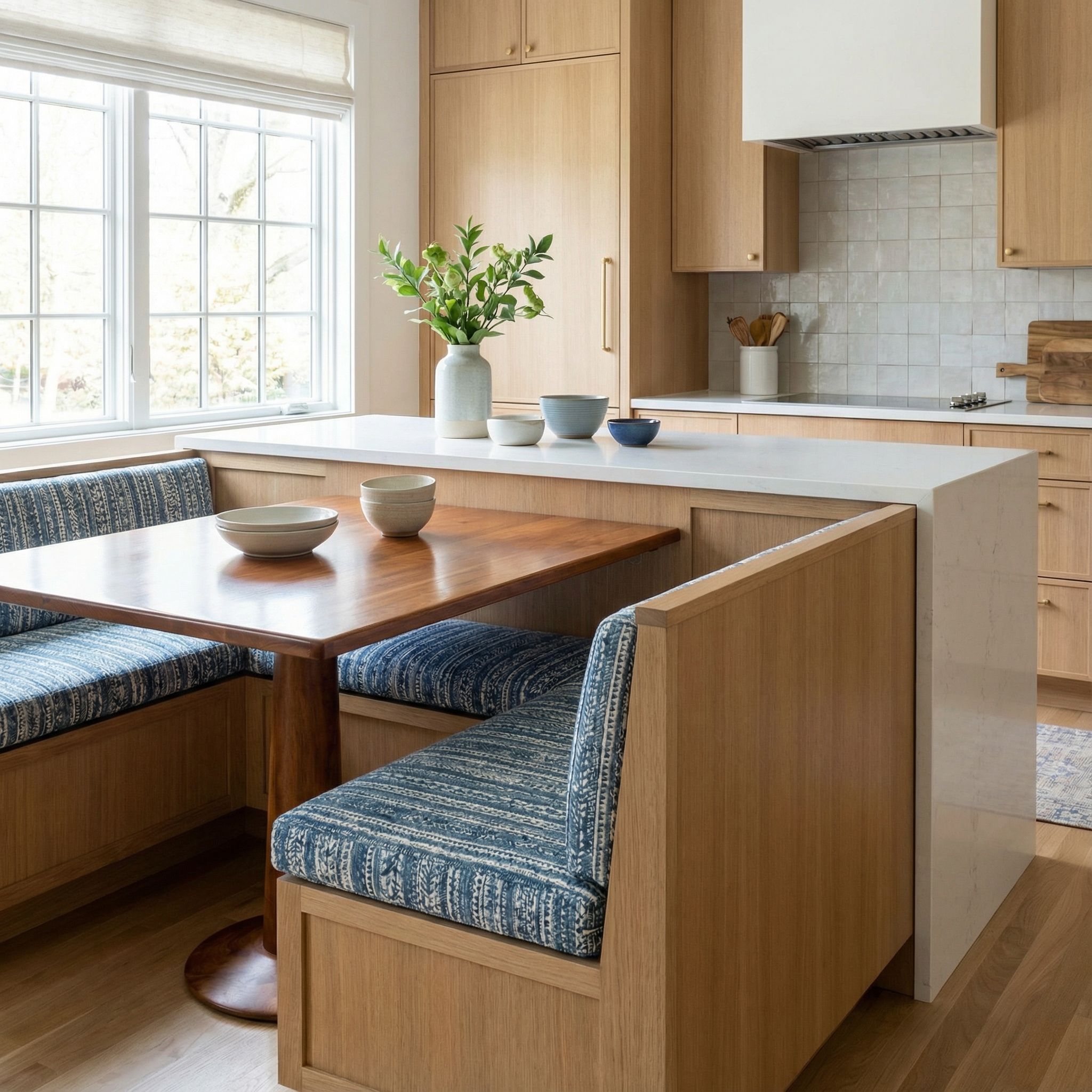
Patterned cushions inject personality and visual energy into nook seating, allowing easily updatable style without structural renovation. Florals, geometrics, or stripes introduce color and texture that soften hard kitchen surfaces while expressing personal taste. Patterns disguise inevitable stains better than solids, offering practical advantages alongside aesthetic appeal. This choice demonstrates that kitchens can embrace decorative elements traditionally reserved for living spaces, blurring boundaries between utilitarian and beautiful, between functional and joyful, creating spaces that nourish souls alongside bodies through thoughtful, personality-rich design.
Multi-Functional Kitchen Island Dining Nook with Workspace
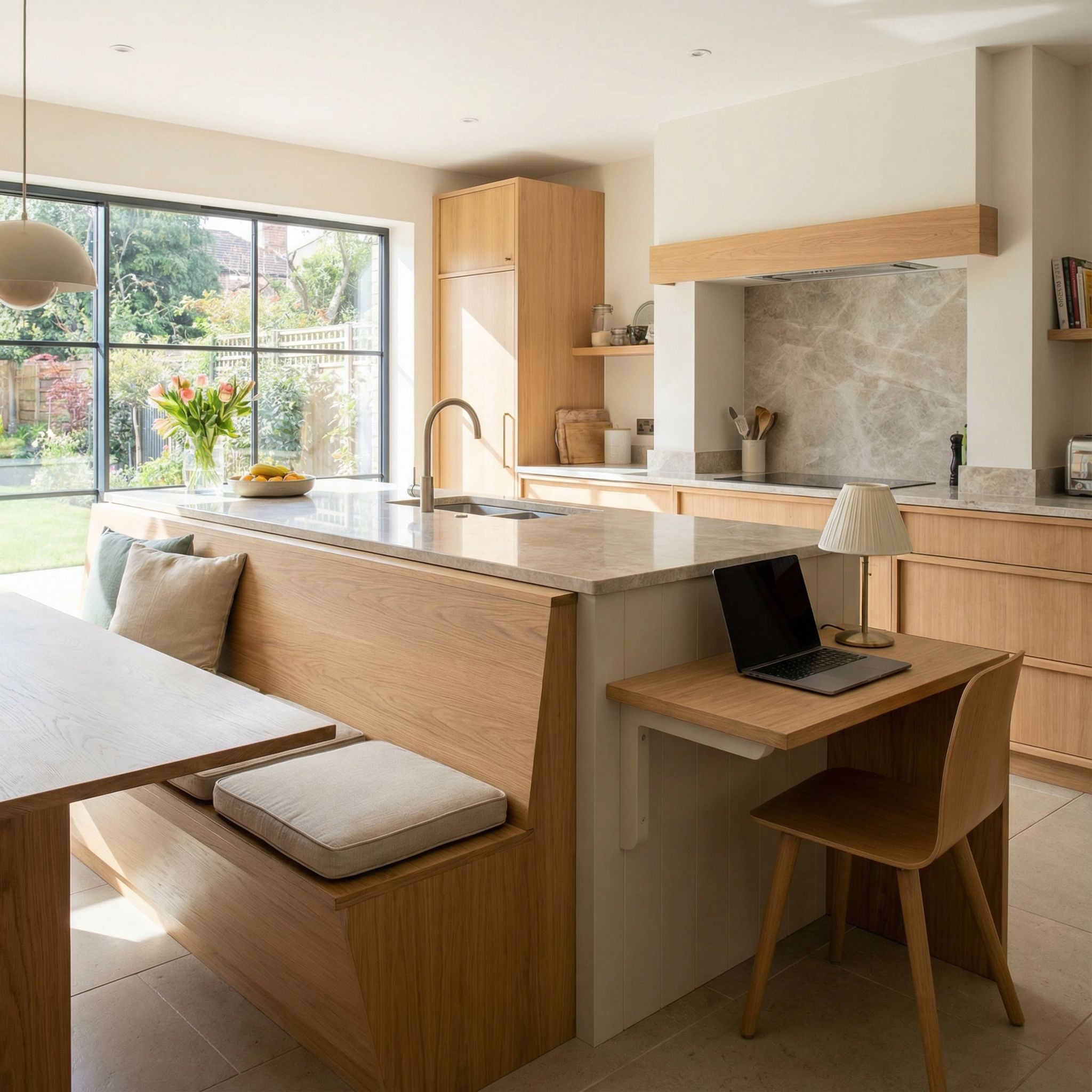
Hybrid nooks incorporating workspace acknowledge that modern kitchens serve as offices, homework stations, and command centers beyond meal service. Integrated outlets, task lighting, and storage for supplies transform dining benches into productive environments that support multiple daily activities. This flexibility reflects contemporary life’s boundary dissolution between work and home, requiring spaces that adapt throughout the day. Multi-functional design maximizes real estate value while accommodating the complex, layered ways families actually inhabit homes, proving that the best spaces serve diverse needs without requiring multiple dedicated rooms.
Kitchen Island Dining Nook with Statement Backsplash Design
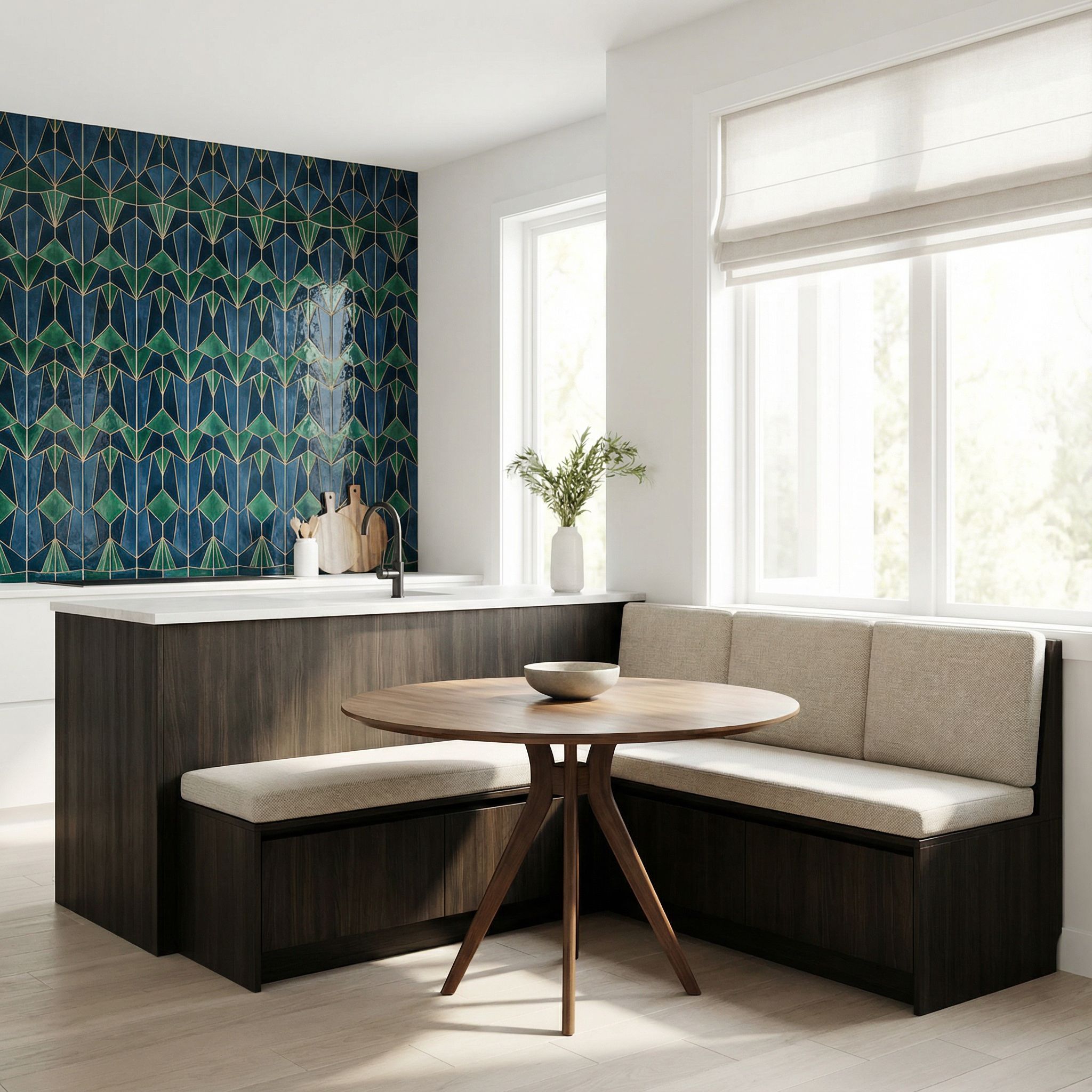
Statement backsplashes behind nook seating create focal points that anchor the space visually while protecting walls from food splatter and scuff marks. Bold tile patterns, dramatic stone slabs, or artistic mosaics transform functional surfaces into gallery walls that reflect personal style. This vertical real estate offers opportunities for color, pattern, and texture that might overwhelm if applied to larger surfaces, allowing confident design moves in controlled doses. Statement backsplashes prove that beauty and function needn’t compete but rather enhance each other when thoughtfully integrated into cohesive, personality-rich kitchen environments.



